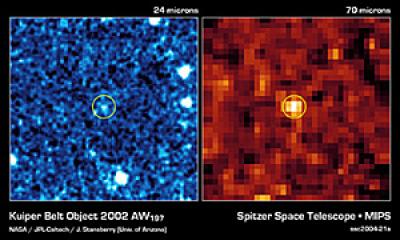Roughly 1,000 Kuiper Belt objects have been discovered orbiting beyond Neptune since the first was found in 1992. Now researchers are suggesting that these icy objects — considered to be leftover building blocks of the solar system — are much smaller than was originally thought. The key is albedo, a measure of how much light an object reflects. Using a presumed albedo of four percent, which is the figure for comets, astronomers had calculated the size of the Kuiper Belt objects, and believed there were more than 10,000 KBOs with diameters greater than 100 kilometers (62 miles), compared to 200 asteroids known to be that large in the main asteroid belt between Mars and Jupiter.
But all these measurements depend on an accurate read on albedo. A higher albedo means a more reflective object, forcing a reassessment of how large the KBO objects really are.

Image: Kuiper Belt Object 2002 AW197 (Image: NASA/JPL/John Stansberry, University of Arizona)
And as reported at the ongoing meeting of the American Astronomical Society’s Division of Planetary Science in Louisville, results from a recent survey of 30 Kuiper Belt objects do indeed reveal a much higher albedo. One object, a KBO designated 2002 AW197, reflects 18 percent of its incident light and is thus calculated to be about 700 kilometers (435 miles) in diameter. The data came from the Spitzer Space Telescope’s Multiband Imaging Photometer (MIPS).
From a University of Arizona press release:
…MIPS detected heat from a Kuiper Belt Object with a surface temperature of around minus 370 degrees Fahrenheit at an astonishing distance of 4.4 billion miles (7 billion kilometers), or one-and-a-half times farther away from the sun than Pluto.
Without MIPS, astronomers operating under the assumption that 2002 AW197 reflects four percent of its incident light would calculate that it is 1500 kilometers (932 miles) in diameter, or two-thirds as large as Pluto…
The reality: the object is about half the size of Pluto’s moon Charon, and only about thirty percent as large as Pluto itself. And the notion that Pluto is just another Kuiper Belt object rather than a planet in its own right comes into serious question; it’s just too big.
More tomorrow on a possible extrasolar planetary find using the Spitzer instrument.

